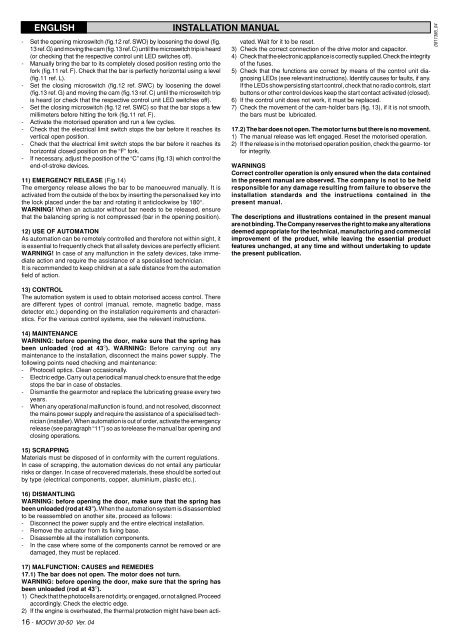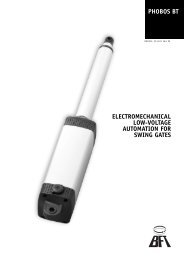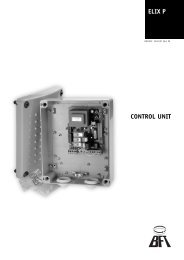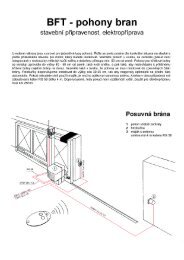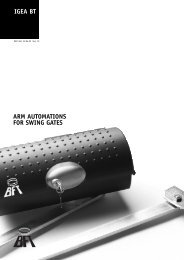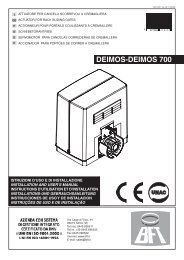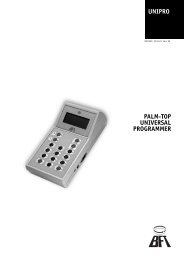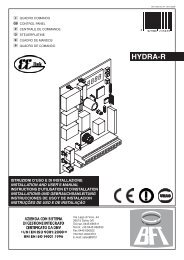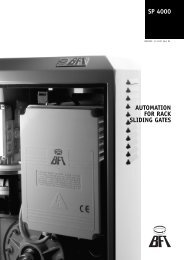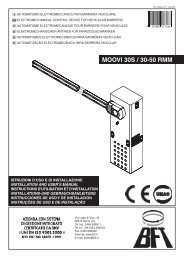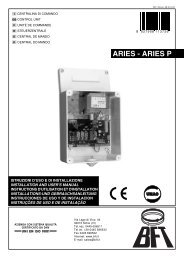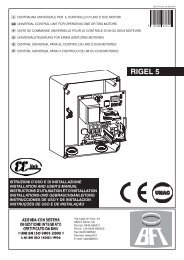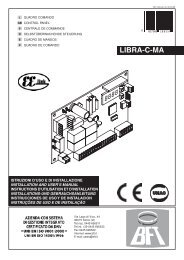ENGLISH- Set the opening microswitch (fig.12 ref. SWO) by loosening the dowel (fig.13 ref. G) and moving the cam (fig.13 ref. C) until the microswitch trip is heard(or checking that the respective control unit LED switches off).- Manually bring the bar to its completely closed position resting onto thefork (fig.11 ref. F). Check that the bar is perfectly horizontal using a level(fig.11 ref. L).- Set the closing microswitch (fig.12 ref. SWC) by loosening the dowel(fig.13 ref. G) and moving the cam (fig.13 ref. C) until the microswitch tripis heard (or check that the respective control unit LED switches off).- Set the closing microswitch (fig.12 ref. SWC) so that the bar stops a fewmillimeters before hitting the fork (fig.11 ref. F).- Activate the motorised operation and run a few cycles.- Check that the electrical limit switch stops the bar before it reaches itsvertical open position.- Check that the electrical limit switch stops the bar before it reaches itshorizontal closed position on the “F” fork.- If necessary, adjust the position of the “C” cams (fig.13) which control theend-of-stroke devices.11) EMERGENCY RELEASE (Fig.14)The emergency release allows the bar to be manoeuvred manually. It isactivated from the outside of the box by inserting the personalised key intothe lock placed under the bar and rotating it anticlockwise by 180°.WARNING! When an actuator without bar needs to be released, ensurethat the balancing spring is not compressed (bar in the opening position).12) USE OF AUTOMATIONAs automation can be remotely controlled and therefore not within sight, itis essential to frequently check that all safety devices are perfectly efficient.WARNING! In case of any malfunction in the safety devices, take immediateaction and require the assistance of a specialised technician.It is recommended to keep children at a safe distance from the automationfield of action.INSTALLATION MANUAL17) MALFUNCTION: CAUSES and REMEDIES17.1) The bar does not open. The motor does not turn.WARNING: before opening the door, make sure that the spring hasbeen unloaded (rod at 43°).1) Check that the photocells are not dirty, or engaged, or not aligned. Proceedaccordingly. Check the electric edge.2) If the engine is overheated, the thermal protection might have been activated.Wait for it to be reset.3) Check the correct connection of the drive motor and capacitor.4) Check that the electronic appliance is correctly supplied. Check the integrityof the fuses.5) Check that the functions are correct by means of the control unit diagnosingLEDs (see relevant instructions). Identify causes for faults, if any.If the LEDs show persisting start control, check that no radio controls, startbuttons or other control devices keep the start contact activated (closed).6) If the control unit does not work, it must be replaced.7) Check the movement of the cam-holder bars (fig. 13), if it is not smooth,the bars must be lubricated.17.2) The bar does not open. The motor turns but there is no movement.1) The manual release was left engaged. Reset the motorised operation.2) If the release is in the motorised operation position, check the gearmo- torfor integrity.WARNINGSCorrect controller operation is only ensured when the data containedin the present manual are observed. The company is not to be heldresponsible for any damage resulting from failure to observe theinstallation standards and the instructions contained in thepresent manual.The descriptions and illustrations contained in the present manualare not binding. The Company reserves the right to make any alterationsdeemed appropriate for the technical, manufacturing and commercialimprovement of the product, while leaving the essential productfeatures unchanged, at any time and without undertaking to updatethe present publication.D811386_0413) CONTROLThe automation system is used to obtain motorised access control. Thereare different types of control (manual, remote, magnetic badge, massdetector etc.) depending on the installation requirements and characteristics.For the various control systems, see the relevant instructions.14) MAINTENANCEWARNING: before opening the door, make sure that the spring hasbeen unloaded (rod at 43°). WARNING: Before carrying out anymaintenance to the installation, disconnect the mains power supply. Thefollowing points need checking and maintenance:- Photocell optics. Clean occasionally.- Electric edge. Carry out a periodical manual check to ensure that the edgestops the bar in case of obstacles.- Dismantle the gearmotor and replace the lubricating grease every twoyears.- When any operational malfunction is found, and not resolved, disconnectthe mains power supply and require the assistance of a specialised technician(installer). When automation is out of order, activate the emergencyrelease (see paragraph “11”) so as torelease the manual bar opening andclosing operations.15) SCRAPPINGMaterials must be disposed of in conformity with the current regulations.In case of scrapping, the automation devices do not entail any particularrisks or danger. In case of recovered materials, these should be sorted outby type (electrical components, copper, aluminium, plastic etc.).16) DISMANTLINGWARNING: before opening the door, make sure that the spring hasbeen unloaded (rod at 43°). When the automation system is disassembledto be reassembled on another site, proceed as follows:- Disconnect the power supply and the entire electrical installation.- Remove the actuator from its fixing base.- Disassemble all the installation components.- In the case where some of the components cannot be removed or aredamaged, they must be replaced.16 - <strong>MOOVI</strong> <strong>30</strong>-<strong>50</strong> Ver. 04
D811386_04Nous vous remercions pour avoir choisi ce produit. Nous sommes certainsqu’il vous offrira les performances que vous souhaitez. Lisez attentivementla brochure “AVERTISSEMENTS” et le “MANUEL D’INSTRUCTIONS” quiaccompagnent ce produit, puisqu’ils fournissent d’importantes indicationsconcernant la sécurité, l’installation, l’utilisation et l’entretien.Ce produit est conforme aux règles reconnues de la technique et auxdispositions de sécurité. Nous certifions sa conformité avec les directiveseuropéennes suivantes: 89/336/CEE, 73/23/CEE, 98/37 CEE etmodifications successives.1) GENERALITESBarrière électromécanique compacte apte pour délimiter des aires privées,des parkings, des accès uniquement pour véhicules. Disponible pourpassages de 3 à 5 mètres. Des fins de course électromécaniques réglablesassurent la position correcte d’arrêt de la lisse. En cas d’usage intensif, uncapteur thermique active le ventilateur de refroidissement.Le déblocage d’urgence pour la manoeuvre manuelle est commandé parune serrure avec clé personnalisée.Le vérin est toujours fourni prédisposé pour le montage àgauche. En casde besoin, il est possible d’inverser la direction d’ouverture par des simplesopérations.La plaque d’assise mod. CBO (en option) facilite l’installation de la barrière.Des prédispositions spéciales facilitent l’installation des accessoires sansbesoin d’effectuer des perforations.2) SECURITE GENERALEATTENTION! Une installation erronée ou une utilisation impropre duproduit peuvent provoquer des lésions aux personnes et auxanimaux ou des dommages aux choses.• Lisez attentivement la brochure “Avertissements” et le “Manueld’instructions” qui accompagnent ce produit, puisqu’ils fournissentd’importantes indications concernant la sécurité, l’installation, l’utilisationet l’entretien.• Eliminer les matériaux d’emballage (plastique, carton, polystyrène etc.)selon les prescriptions des normes en vigueur. Ne pas laisser desenveloppes en nylon et polystyrène à la portée des enfants.• Conserver les instructions et les annexer à la fiche technique pour lesconsulter à tout moment.• Ce produit a été conçu et réalisé exclusivement pour l’utilisation indiquéedans cette documentation. Des utilisations non indiquées dans cettedocumentation pourraient provoquer des dommages au produit et représenterune source de danger pour l’utilisateur.• La Société décline toute responsabilité dérivée d’une utilisation impropreou différente de celle à laquelle le produit a été destiné et qui est indiquéedans cette documentation.• Ne pas installer le produit dans une atmosphère explosive.• Les éléments constituant la machine doivent être conformes aux DirectivesEuropéennes suivantes: 89/336/CEE, 73/23/CEE, 98/37 CEE etmodifications successives. Pour tous les Pays en dehors du MarchéCommun, outre aux normes nationales en vigueur il est conseillé derespecter également les normes indiquées cihaut afin d’assurer un bonniveau de sécurité.• La Société décline toute responsabilité en cas de non respect des règlesde bonne technique dans la construction des fermetures (portes, portailsetc.), ainsi qu’en cas de déformations pouvant se produire pendantl’utilisation.• L’installation doit être conforme aux prescriptions des DirectivesEuropéennes: 89/336/CEE, 73/23/CEE, 98/37 CEE et modificationssuccessives.• Couper l’alimentation électrique avant d’effectuer n’importe quelleintervention sur l’installation. Débrancher aussi les éventuelles batteriesde secours.• Prévoir sur la ligne d’alimentation de la motorisation un interrupteur ou unmagnétothermique omnipolaire avec distance d’ouverture des contactségale ou supérieure à 3mm.• Vérifier qu’en amont de la ligne d’alimentation il y a un interrupteurdifférentiel avec seuil de 0,03A.• Vérifier si l’installation de terre est effectuée correctement: connectertoutes les parties métalliques de la fermeture (portes, portails etc.) et tousles composants de l’installation dotés de borne de terre.• Appliquer tous les dispositifs de sécurité (cellules photoélectriques, barrespalpeuses etc.) nécessaires à protéger la zone des dangers d’écrasement,d’entraînement, de cisaillement, selon et conformément aux directives etaux normes techniques applicables.• Appliquer au moins un dispositif de signalisation lumineuse (feu clignotant)en position visible, fixer à la structure un panneau de Attention.• La Société décline toute responsabilité en matière de sécurité et de bonfonctionnement de la motorisation si des composants d’autres producteurssont utilisés.MANUEL D’INSTALLATIONFRANÇAIS• Utiliser exclusivement des pièces originales pour n’importe quel entretienou réparation.• Ne pas effectuer des modifications aux composants de la motorisation sinon expressément autorisées par la Société.• Informer l’utilisateur de l’installation sur les systèmes de commandeappliqués et sur l’exécution de l’ouverture manuelle en cas d’urgence.• Ne pas permettre à des personnes et à des enfants de stationner dans lazone d’action de la motorisation.• Ne pas laisser des radio commandes ou d’autres dispositifs de commandeà portée des enfants afin d’éviter des actionnements involontaires de lamotorisation.• L’utilisateur doit éviter toute tentative d’intervention ou de réparation de lamotorisation et ne doit s’adresser qu’à du personnel qualifié.• Tout ce qui n’est pas expressément prévu dans ces instructions, estinterdit.3) CARACTERISTIQUES TECHNIQUES<strong>MOOVI</strong> <strong>30</strong>-<strong>50</strong>Alimentation: ........................................................ 2<strong>30</strong>Va.c.±10% <strong>50</strong> Hz (*)Puissance absorbée: ........................................................................ <strong>30</strong>0WMoteur: ........................................................................ 1400 min -1 (4 pôles)Condensateur: ............................. 8 µF (alim. 2<strong>30</strong> V): 32 µF (alim. 110 V)Courant absorbé: .......................... 1.4 A (alim. 2<strong>30</strong>V): 2.4 A (alim. 110 V)Classe d’isolation: .................................................................................... FTempérature d’intervention ventilation: ................ 110°C (enroulement) Température d’intervention disjoncteur:............................................. 1<strong>30</strong>°CLubrification réducteur: .............................................. Graisse permanenteCouple maxi: .................................. <strong>MOOVI</strong>-<strong>30</strong> 85Nm: <strong>MOOVI</strong>-<strong>50</strong> 2<strong>50</strong>NmTemps d’ouverture: ................................... <strong>MOOVI</strong>-<strong>30</strong> 4 s: <strong>MOOVI</strong>-<strong>50</strong> 8 sLongueur de la lisse (aluminium):<strong>MOOVI</strong>-<strong>30</strong> - 3m max.: <strong>MOOVI</strong>-<strong>50</strong> - 5m max.Réaction au choc (barre palpeuse): ............................... Arrêt et inversionFins de course: .................................Electriques incorporées et réglablesManoeuvre manuelle: ...................................... Déverrouillage rapide àcléN° manoeuvres dans les 24 heure: ...... <strong>50</strong>-(<strong>MOOVI</strong>-<strong>30</strong>): <strong>30</strong>-(<strong>MOOVI</strong>-<strong>50</strong>)Température d’exercice: ........................................................... -10 +55°CDegré de protection: ............................................................................IP24Poids du vérin (sans lisse): ............................................................. 35,6kgDimensions: ................................................................................. Voir fig.1CENTRALE DE COMMANDE MIZAR-BOMAlimentation: ........................................................ 2<strong>30</strong>Va.c.±10% <strong>50</strong> Hz (*)Courant absorbé à vide: ................................................................ 100 mASortie alim. accessoires: .......................................... 24Vac 200 mA maxiPuissance maxi absorbée de moteur: ..............................................<strong>50</strong>0WFin de course: ............................................................................. electriqueTemp de travail: .......................................................... réglable de 1 à <strong>30</strong>sTempérature d’utilisation: ......................................................... -10 +55 °C(*) Tensions d’alimentation spéciales en option.4) ACCESSOIRES EN OPTION (Fig. 17)- Plaque d’assise CBO- Kit de protection anti-cisaillement KIT <strong>MOOVI</strong> PRM- Kit colonnette de fixation Cellula 1<strong>30</strong> KIT <strong>MOOVI</strong> 1<strong>30</strong>- Fourche fixe d’appui de la lisse FAF- Lyre de repos pour lisse <strong>MOOVI</strong> GA (Uniquement pour le modèle <strong>MOOVI</strong> <strong>50</strong>)- Lyre de repos amortie pour lisse <strong>MOOVI</strong> GAMA- Rideau de lisse déjà assemblée à la lisse SB- Barre palpeuse BIR- Kit lumières pour lisses de 3m à 4,5m KIT <strong>MOOVI</strong> LIGHT- Kit lumières pour lisses de 5m ou 6m KIT <strong>MOOVI</strong> LIGHT 1- Profil de couverture inférieur ou supérieur de la lisse <strong>MOOVI</strong> PCAPour d’autres renseignements sur l’installation et l’utilisation des accessoires,se référer au manuel d’instructions correspondant.5) PLAQUE D’ASSISE (Fig.2)- Creuser une fosse adéquate au type de terrain.- Prédisposer plusieurs conduites pour le passage des c‚bles électriques.- Positionner les vis fournies en dotation avec la base mod. CBO dans les4trous de fixation avec le filet vers le haut. Souder les têtes des 4 vis àlabase et protéger les soudures avec de l’antirouille. Positionner la base detelle façon qu’elle avance d’environ 20 mm du sol (fig.2).- Remplir la fosse de béton, en contrôlant la position de la base dans lesdeux sens avec un niveau àbulle et laisser le ciment se durcir.6) MONTAGE DU VERINATTENTION! La barrière doit être exclusivement utilisée pour lepassage des véhicules. Les piétons ne doivent pas passer dansl’aire de manoeuvre de l’automation. Prévoir un passage piétonsspécial.<strong>MOOVI</strong> <strong>30</strong>-<strong>50</strong> Ver. 04 - 17


